Sometimes history research is a bit like Alice taking a tumble into the rabbit hole. You never know where you will end up or what you will find! Recently, a group of researchers trying to answer questions about the Ivey-Ellington House fell down the proverbial rabbit hole and ended up looking for answers regarding E O Waldo’s Drug Store! We started with this photo, which had surfaced some time ago and had reappeared in a query from Michael Rubes who is working on a presentation about the Ivey-Ellington House. (See "Upcoming Events" on our Home Page.) That’s all it took to set off in the search for answers.
Based on what we know about 1900s Cary, the building couldn’t be immediately placed. It looks remarkably like what is known today as Scott’s Store on West Chatham Street beside the former location of the Ivey-Ellington House. What we know about surrounding buildings on West Chatham Street, it was clear that the two buildings were indeed two different buildings, not the same structure.
.jpg)
One researcher (Carla) remembered a map drawn from Elva Templeton’s memories of early Cary. Elva was the daughter of Dr James McPherson Templeton, and Elva placed various homes and businesses on streets in Cary around 1906 or so. Here is a section of a map drawn from her recollections:
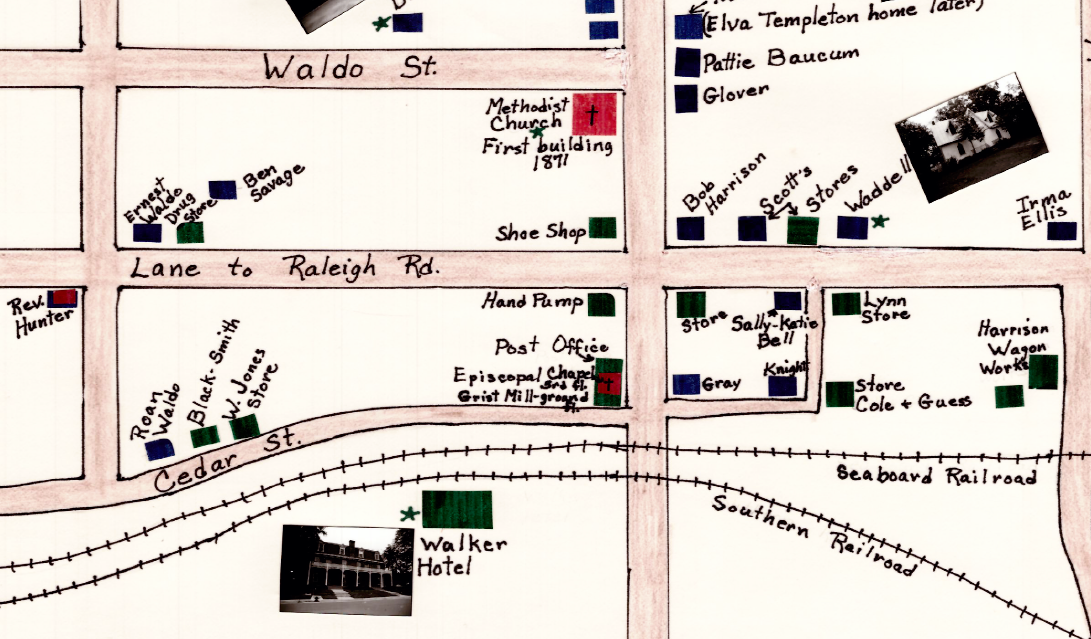
On this map, what is marked “Lane to Raleigh Rd” is now known as East Chatham Street. During this time, businesses were located on Cedar Street and what today is known as West Chatham Street, both of which served as the business “district” of Cary in the late 1800s and 1900s. Just above the word “Lane” appear two buildings marked “Ernest Waldo Drug Store”. It is open to interpretation as to whether one was a home and one was a business. The two buildings sat at the corner of what is now East Chatham and Walker Street on the property of today’s Modern Service, an automotive repair shop.
Now, take a look at a photo of Cary’s fire trucks arranged on the Modern Service property, circa 1950s, looking east to Raleigh. The street on the left of the photo is East Chatham Street. You will see a home in the background of the color photograph in approximately the same location as the home in the black and white photograph above, which is just visible. The houses are oriented the same way, facing Walker Street, although the roof of the house in the color photo may have been altered.
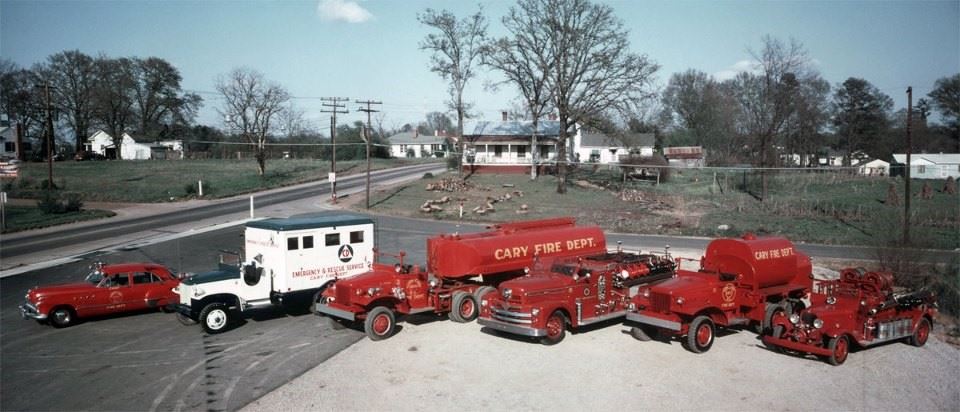
In a bit of serendipity, another conversation about a completely unrelated subject brought to one researcher’s (Carla’s) attention an old newspaper in the collection of the Page Walker Arts and History Center. The newspaper had been donated by Jerry Miller. Carla made a phone call to Mr Miller and found that Mr Miller had been given the newspaper by Mr R O Heater, who wanted Jerry to draw pictures of the houses in the newspaper that didn’t exist any longer. Mr Heater had emphasized to Jerry how important the newspaper was. Mr Miller also mentioned that he had donated it to the Page Walker Arts and History Center. Carla joined the Center’s supervisor, Kris Carmichael, in looking at this newspaper. To Carla's surprise, within the pages of the “Farmer’s Journal”, published by Dr J M Templeton in 1913, was a photograph of the E O Waldo Drug Store with the caption, “E O Waldo Drug Store, East Chatham Street.” Bingo. This was confirmation that the pieces of the puzzle regarding the drug store that we guessed at were accurately put together. It also underscored the value of saving documents from the past.
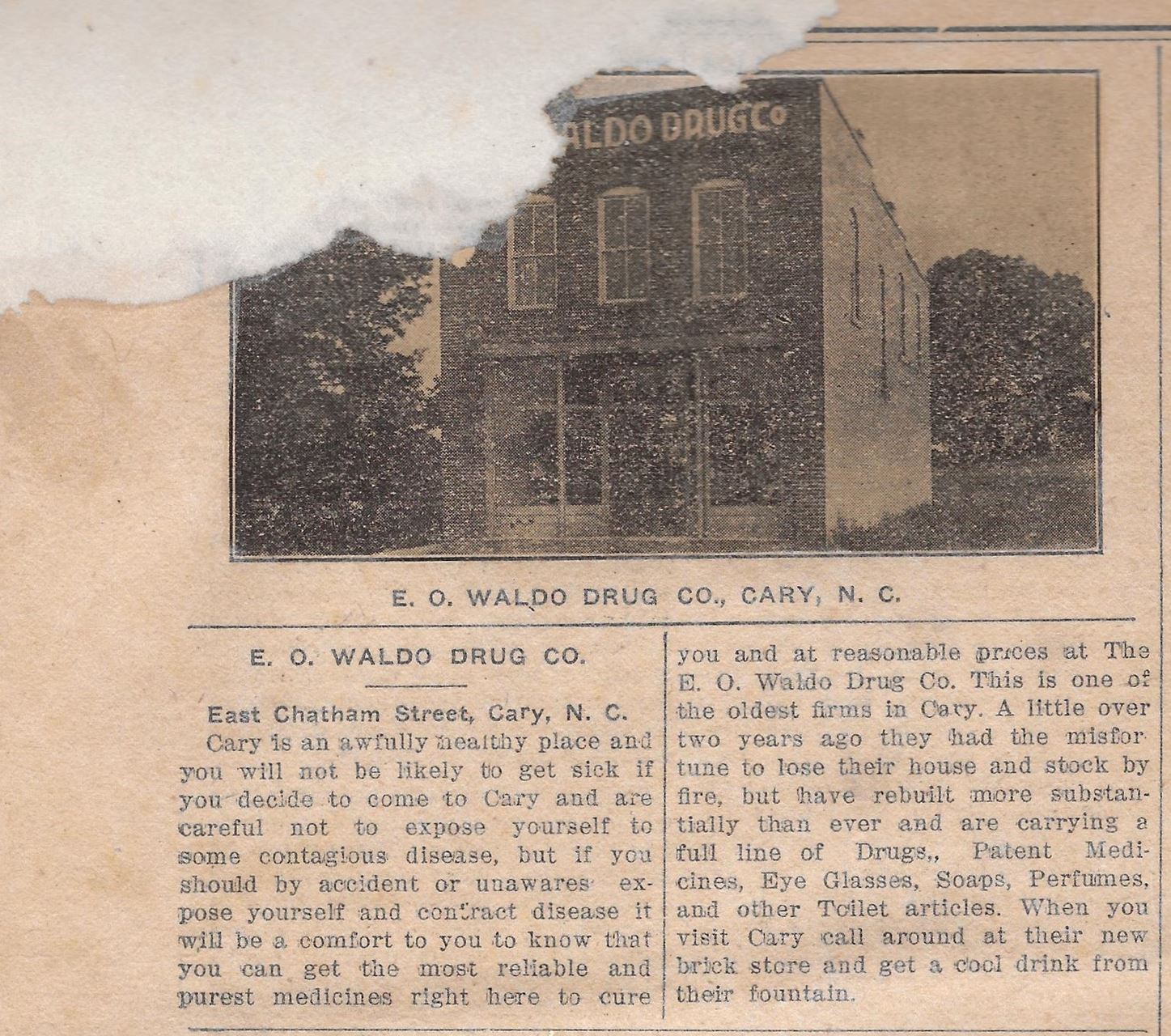
There are some differences in the two photographs of the building, which are explainable. The newspaper photograph does not have the stairs on the outside of the building and does not show any telephone wires. Those came later, as evidenced in the stand-alone photograph. The signage above the front door is different in style, if not in content, but could have needed refreshing over the years. The article above states that two years previously, fire had destroyed “their house and stock.” Does this mean a separate house and a business as pictured on the hand-drawn map? In the photo above, it appears that only the business has been rebuilt, but could have contained a residence on the second floor. Maybe that is an explanation for the “more substantially than ever” remark.
But that isn’t all that we found down the rabbit hole. Independently, another researcher (Barb) had been looking through the Thomas Byrd Collection of research documents used in the book “Around and About Cary”. Tom Byrd’s collection has recently been painstakingly digitized and placed online at digitalnc.org.
[https://lib.digitalnc.org/search?ln=en&p=903%3Apagewalker_011419_NPB_01&f=&sf=&so=d&rg=10&fti=0]
Out of curiosity, Barb began to browse the online research documents and found a photocopy of the same newspaper, which Jerry Miller had gifted the Page Walker! The discovery of the digitized newspaper and the original happened at the same time. What a coincidence!
The information in the stand-alone photograph of the drug store with telephone lines led us to another rabbit hole – the history of telephone service in Cary. According to an interview with Irma Ellis, long-time school teacher in Cary and captured in "Around and About Cary," the earliest phone service started in 1899 and was located in Waldo’s Drug Store. We had to go down the rabbit hole again and ask, “Where was THAT store located?” We are not sure, but think it was the drug store started by Dr S P Waldo and probably located on the commercial (and main) street of Cary, Railroad (now Cedar) Street. Apparently, that store burned, too. The drug store seemed to have particularly bad luck with fire. Perhaps it was because the store sold not only medicines but paints, oils, and general merchandise. That is a lot of volatile material! Here is a receipt from 1885 from S P Waldo’s store found in the estate file of Araminta (Mrs A J) Page Clegg, the sister of Frank Page, who lived in Cary and ran the Page Hotel (now the Page Walker Arts and History Center) for Frank and Catherine in the hotel’s early years. After she stopped managing the hotel and it was sold on to the Walkers, she remained in Cary and died here in 1885. Sadly, the receipt doesn’t give the address of the business, but Cary was so small that an address wasn’t needed.
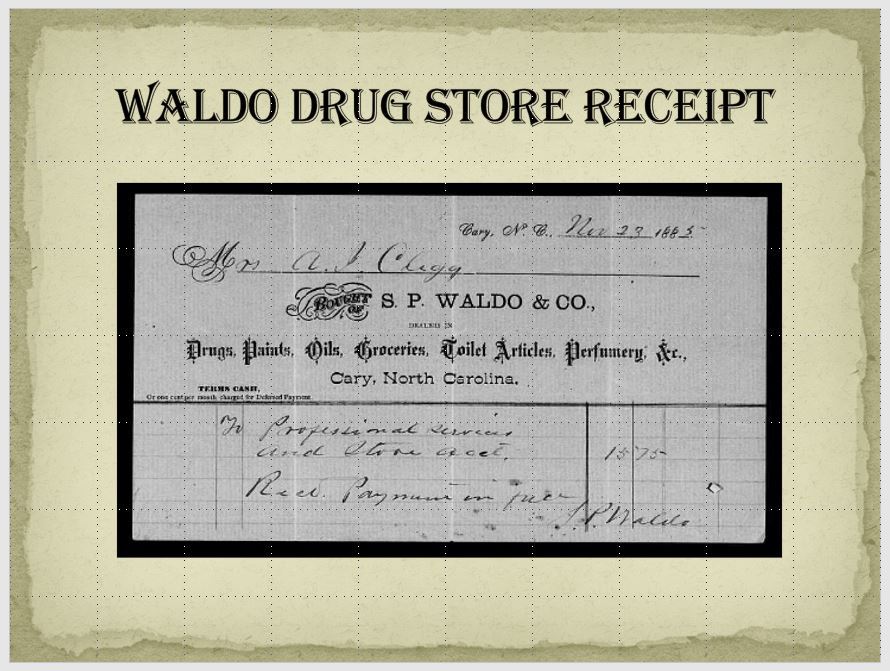
Back to the telephone lines, newspaper clipping shows that the town geared up for the first telephone exchange for the town of Cary in 1915. In the photograph of the drug store below, the signage for the public telephone exchange and the line from the building to the pole are clearly visible, meaning that the photograph was taken in or shortly after 1915.
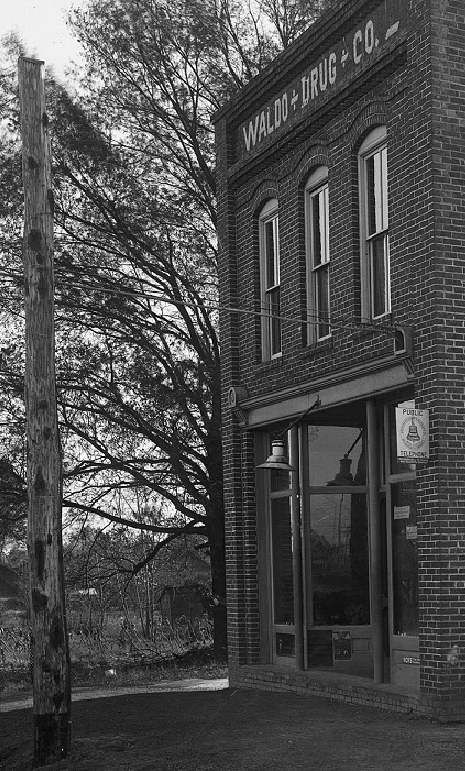
Another bit of information came from old telephone books in the Olivia Raney Library. A few people in Cary had phones before the telephone exchange came to town. A 1916 Telephone Book shows the earliest listing of numbers for Cary, but if you look at the Apex listings, you will see that several homes and businesses had telephone service through the Apex exchange. It’s reasonable to think that since the Cary exchange was established later in 1915, that the 1916 telephone book contained the earliest separate listing of Cary numbers.
In the 1916 telephone book, Mrs Ida F Jordan (residence - Carla's great-grandmother!), J M Templeton Sr, (Dr Templeton) (residence), and N G Yarborough (Nathaniel G Yarborough who owned the Guess-Ogle House), (residence) and The Bank of Cary on the Apex exchange joined 24 other numbers on the Cary exchange. All these numbers eventually were Cary exchange numbers.

If anyone doubts the value of the research that makes up “Around and About Cary”, doubt no more. All one has to do is read the information in that book to learn the details of fires that destroyed the drug store, not once, but twice.
Barb pointed out a paragraph in the book “Around and About Cary” that recounted the last fire. “The telephone switchboard and an apartment occupied by Mr and Mrs Larry Penny were located over Waldo’s Drug Store. Upon returning from the town pump one cold January morning in 1919, Mrs Penny discovered her kitchen ceiling ablaze. Said Mrs Hilliard (Lyda Barbee Hilliard, Cary’s first operator):
People started yelling at me to come down, but I was trying to get the long-distance operator (in Raleigh) so she could send help. Cary didn’t have a fire department at the time, and it was customary for Raleigh to send a wagon out.”
The Raleigh operator never came on line and the building burned. “Our long-distance service was poor,” Mrs Hilliard said.” [Said with a touch of understatement! – Carla]
In another remarkable coincidence, one researcher (Carla) said that her grandmother (Annie Beasley Jordan of Cary) was related to Mrs Hilliard and they were best friends. The researcher knew Mrs Hilliard personally. Too bad Carla didn’t know this story as a girl so she could ask some questions!
About Mr and Mrs Larry Penny! Larry Bryant Penny of Cary and Mary Brown of Apex were married in Cary in 1918 by W H Atkins, a JP. The apartment over the drug store was the home for newlyweds, but the fire shortly thereafter must have put some fear in them as they are listed in records from 1920 on as living in places outside “downtown” Cary. Who would blame them!
But, wait! There is more to sort out about the E O Waldo Drug Store. Ernest Owen Waldo, Sr was the son of Dr S P Waldo, who died very young in 1891, and nee Alice Owen. Ernest ran the drug store with his father, and after Dr Waldo’s death continued the business until his own death on 26 Nov 1909. At that point, Ada Owen, Alice Owen Waldo’s sister, ran the business started by her brother-in-law. Later, the business fell into the hands of Estes L Baucom, who had attended Cary High School. His family was located in Western Wake County, and a relative, A V Baucom, owned and operated a drug store in Apex. Estes L Baucom was listed as the operator of E O Waldo Drug Store in corporate tax records of 1916 – 1917. According to Mary Belle Phillips in an oral interview with Peggy Van Scoyoc, Mr Baucom’s drug store was in the building now known as Ashworth’s Drug Store. We can speculate that after the 1919 fire, he moved the pharmacy up the street and the old burned drug store was not rebuilt. In the estate papers of Alice O Waldo, much was made of old bricks on a particular property which were sold and the proceeds distributed to heirs. Could these have been bricks salvaged from the burned building? It’s hard to tell!
What about the other fire, the one in 1911? This clipping is all we know of details about the fire. Because the photos of the E O Waldo Drug Store show no surrounding buildings, and this clipping says surrounding buildings were saved, it would appear that this fire happened on Railroad (now Cedar) Street and the business was rebuilt on what is now Chatham Street.
.jpg)
We are indebted to many long-gone Cary residents who recorded their memories for future generations. Besides Elva Templeton and her map of Cary, another Cary resident, Terrine Holleman Woodlief, also recorded her recollections in map-form about who lived where in Cary and the businesses of the time. There are similarities between the two maps, but each lady remembered different buildings. Taken together, the two maps fill in many of the gaps that the other left out. On Mrs Woodlief’s map, there is an inset of the “business district” of Cary. On the map below, Railroad Street runs across the top from left to right. Beside the brick factory, you will see a building labeled “drug store”. It is reasonable to assume that this is the drug store that burned and was reconstructed on East Chatham Street. The order of businesses lines up with our current understanding of the placement of the brick building, Jones Store and blacksmith. More research is needed on who Williams was and the type of store he/she operated.

Another detail emerged late in the research. A daughter of Dr Waldo and Alice Owen Waldo, his wife, was Ruth Yarrell Waldo (later Mrs John Wesley Brothers), who operated the phone exchange on the property of the US Post Office on Academy Street in Cary. She came by her knowledge of telephones through the family! Deed research indicates that the property passed through the Waldo family, was owned by Ada Owen, sister-in-law of Dr S P Waldo and was contiguous to the original site of his home that has since been moved, restored, and now sits behind the Mayton Inn on East Park Street. Carla’s father, C Y Jordan, who was born in 1927 in Cary and lived almost his entire life here, told a story about visiting the house with his older cousin Betty Jordan. They knew they were allowed to observe the exchange operator, but they also knew they had to maintain complete silence! They were permitted inside because Betty’s widowed mother, Lila Westbrook Jordan operated the exchange for a time, most likely in the mid-1930s! C Y could “mimic” Mrs Jordan, who he remembered would say “Number, please” in a high-pitched voice when someone rang into the exchange for assistance. That must have been a time when more people in Cary had phones, maybe too many numbers for an operator to quickly remember who had which number!
Just when we think we are reaching the end of the rabbit hole, something new emerges! A researcher (Michael Rubes, this time) found a group of photos in Flickr that showed views of “old” Cary. One showed a house described as the telephone exchange in Cary circa 1930 on Academy Street, noted above. This photo must be the Brothers House. It is described in deeds as a “5-room cottage on Academy Street.” C Y Jordan remembers there being two houses on the current Post Office lot, and the photo bears this out. The sign in front of the house is a wonderful detail. Southern Bell contracted to lease the house from Ada Owen for two five-year terms which ran from 1929 to 1939. The leases were found in the Wake County, NC Register of Deeds office, with deeds available online.

Michael also pointed us to a photo circa 1910 of a phone operator in Cary. So, we circle back around to the Waldo Drug Store on East Chatham Street. Because the date assigned is approximate, it is reasonable to think that this photo was taken in the two-story building with the phone exchange upstairs. Note the pot-bellied stove and lacy curtains. Too bad we can’t see what is hanging on the wall to the right of the window. Is it a calendar that would show the month and year? Hard to say, but we can almost read the clock on the table beneath! What time do you think it says? Referring back to the first photo in the blog, there is a pipe coming out of the side wall on the second floor. Is that the stove pipe we see in the photo below? If so, the window may be the right-hand second floor window as you face the building. And is this the first operator, Lyda Barbee, before her marriage to Mr Hilliard? The 1910 Census doesn’t shed light on her occupation, as she was only 15 at the time. She finished at Cary High School in 1915 or 1916. The 1920 Census shows her living at home on Walnut Street and working as a clerk in the telephone office. The unanswered question is whether she worked in her late teens for the telephone exchange. In 1919, at the time of the last, disastrous fire, she would have been about 24 and could have started working at the exchange when she finished high school. Based on the date of the exchange, September 1915, she would have been 19 or 20, plenty mature enough and educated enough to work in the office. Cary High School records list her for the last time as a student in the 1915 CHSite, the yearbook of Cary High School. All the details seem to fall into place.
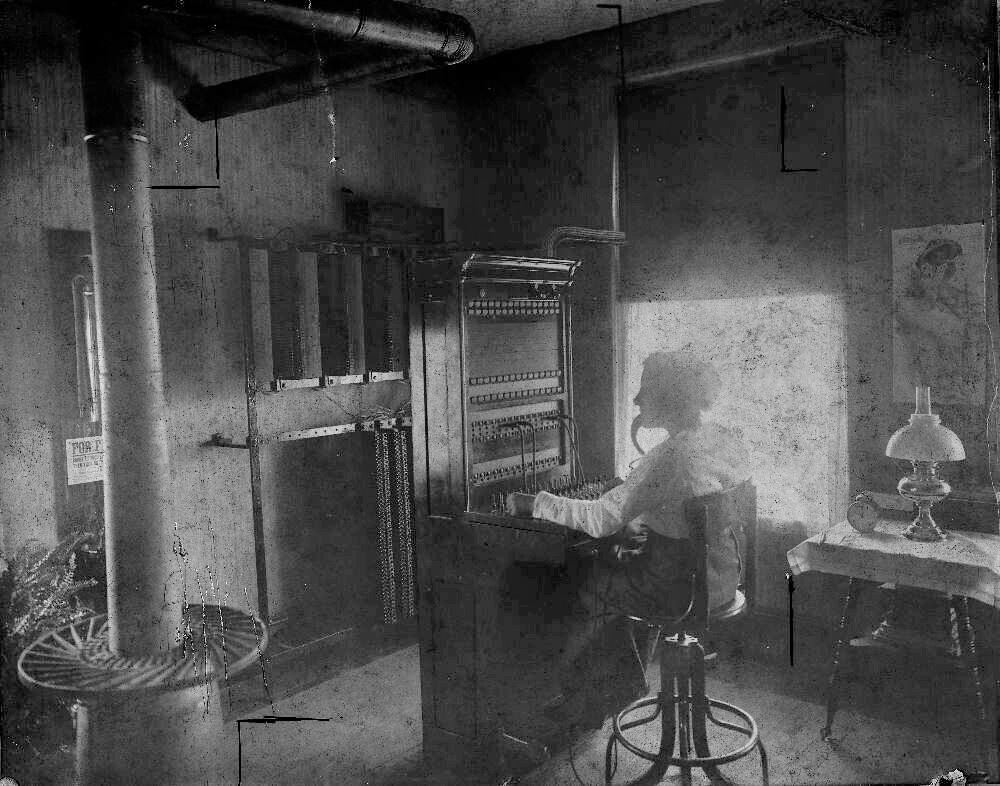
Thus ends our excursion (for the time being) down rabbit hole, with all its twists and turns, serendipitous moments and bunny trails. You have gotten a glimpse into the fun of research and the thrill of the hunt! Many thanks to Tom Byrd, Cary’s original researcher, who captured vital details about Cary’s history that otherwise would have been lost, Jerry Miller who brought long lost structures in Cary to life, and other Cary-ites from long-gone days who left memories which have helped us on our journey. And thanks to Barbara Wetmore, Michael Rubes, and Kris Carmichael for this team effort to try and sort through the details…down the rabbit hole!
